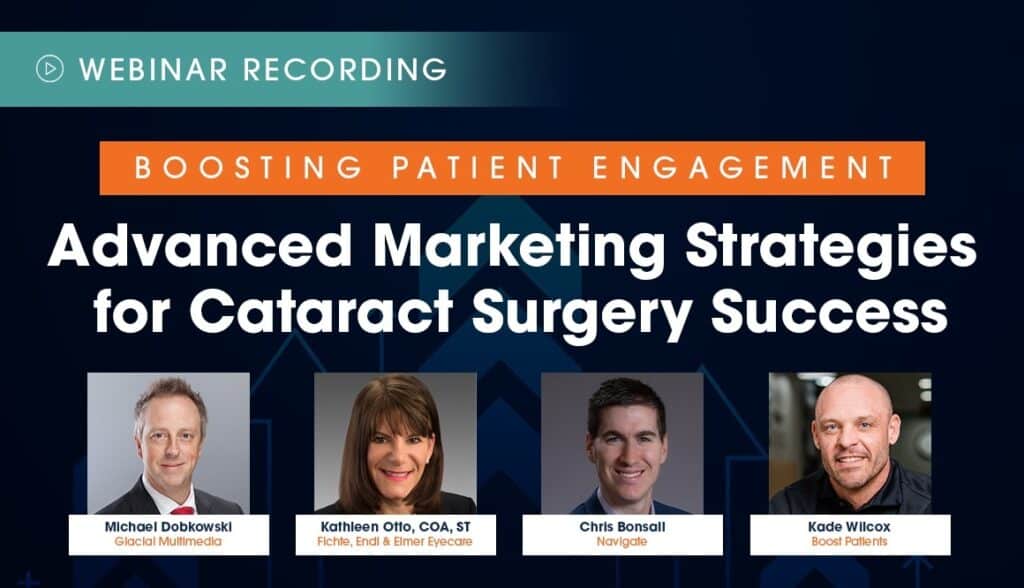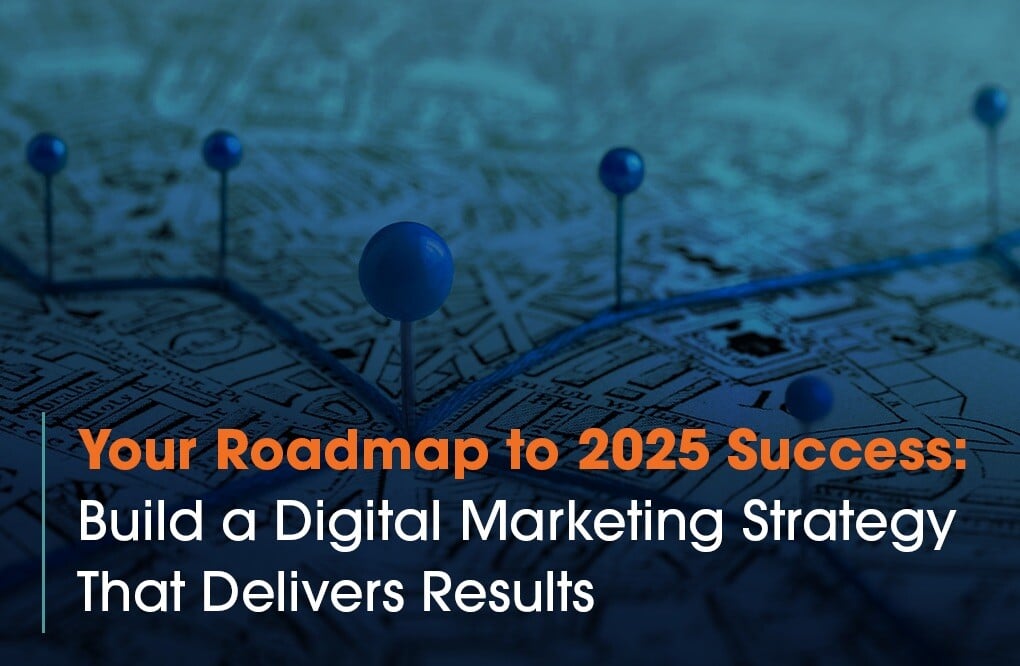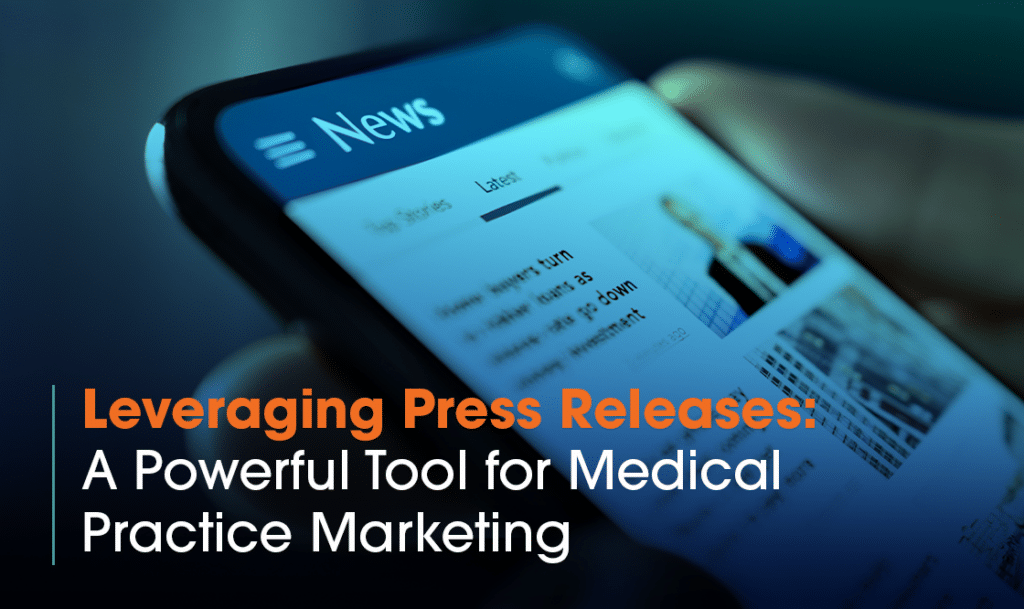Posted on November 11, 2024
Effective Cataract Surgery Marketing: 4 Ways to Build a Profitable Conversion Funnel
Modern Cataract Marketing for Ophthalmology Practices
Practices nationwide are grappling with reduced reimbursements and changing patient behaviors this year. But while some practices struggle, others are discovering innovative approaches to attract and convert premium cataract surgery patients, transforming market challenges into opportunities for unprecedented growth.
“Our cataract surgery and LASIK marketing strategies just aren’t working like they used to.”
If this sounds familiar, you’re not alone.
What’s the Story This Year?
The past year has proven to be a very difficult year for ophthalmology practices. The cataract surgery reimbursement has been cut again and seems to be under constant attack.
Cataract surgery is one of the most popular procedures in the world, and also the most common among Medicare patients. For practices looking to enhance their cataract surgery marketing efforts, understanding these statistics is crucial.
According to Ophthalmology Management magazine:
“Cataract surgery remains the most common surgery performed worldwide. In the United States alone, an estimated 3.7 million cataract surgeries are completed annually.”
However, not only has cataract surgery reimbursement been cut again, but many practices with LASIK services are seeing declines in their LASIK surgery volumes as well. Overall national LASIK volume has reportedly decreased by 19%, with some practices experiencing drops of over 40%. In order to maintain a balance of revenue, what is a practice supposed to do to combat these trends?
What Does Current Cataract Surgery Demand Look Like?
Digital marketing for cataract surgery requires a comprehensive search strategy. When developing an effective cataract surgery marketing strategy, it’s essential to understand current market demands. At Glacial Multimedia, there are two basic methods that we use to measure the demand for cataract surgery.
The first is Glacial’s process of analysis search trends, and the second is our interviews with our network of practices. Based on Google search analysis, the data shows that demand has decreased. With the data showing less demand in the search for cataract related keywords, it makes sense that lead volume will also be down.
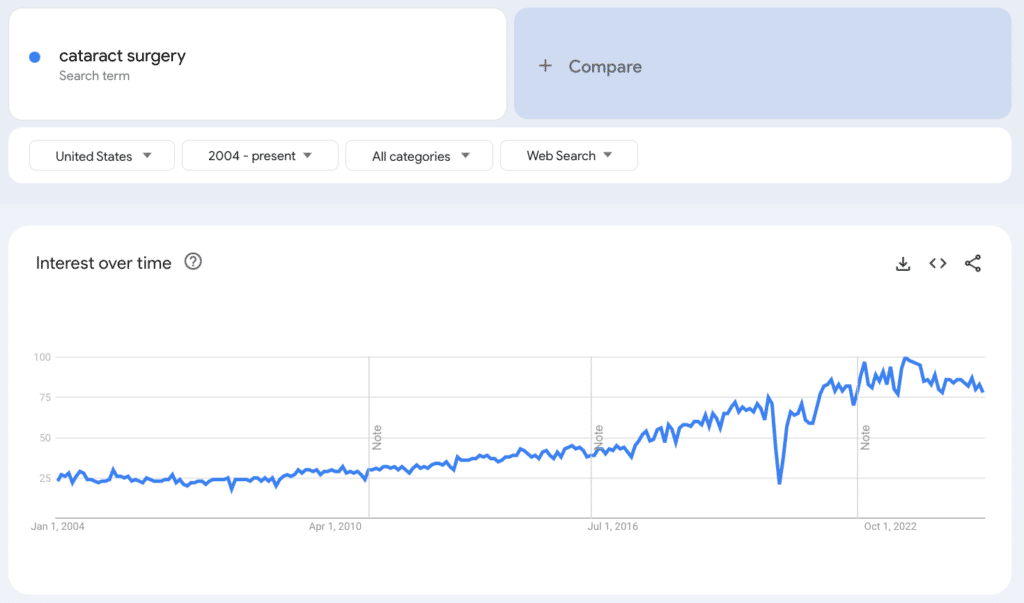
Since this data is based on searches nationwide, local demand can vary depending on the practice’s marketing efforts, their patient education program, and the strength of their referral networks. Practices that invest in attracting patient leads, establish a professional intake process, and follow a structured approach to patient education and interaction tend to experience more consistent demand.
Fine-tuning this process is essential for the future but doesn’t need to be burdensome.
How Are Practices Combating These Changes?
Many cataract surgeons have reached a point where they are starting to try new approaches, whether it’s creating new lines of revenue, enhancing marketing efforts or refining their processes to enable a higher conversion rate.
One key strategy has been Practices making premium lens implants a primary focus. RLE (Refractive Lens Exchange), also called CLR (Clear Lens Replacement), has also emerged as a viable solution for revenue enhancement.
“Patients from their late 40s to late 50s are showing up for RLE consults and are prepared to pay accordingly. We have seen many people show up at consultations that have actually done a lot of research and are looking for lens implants”
– Robert Schnipper, MD (Jacksonville Eye Center)
The combination of new technologies in the premium lens implant space and the financial status of Generation X (ages 45-65) have unveiled a very unique opportunity. Some practices have also started to build revenue lines into the dry eye space, where there is a significant population of underserved patients.
However, with all of these changes, it can be super challenging for practices to initiate on their own. To address these challenges and capitalize on the opportunities, practices must focus on refining key areas that directly impact the conversion process and patient engagement.
4 Areas of Focus for Improving the Overall Cataract Conversion Process
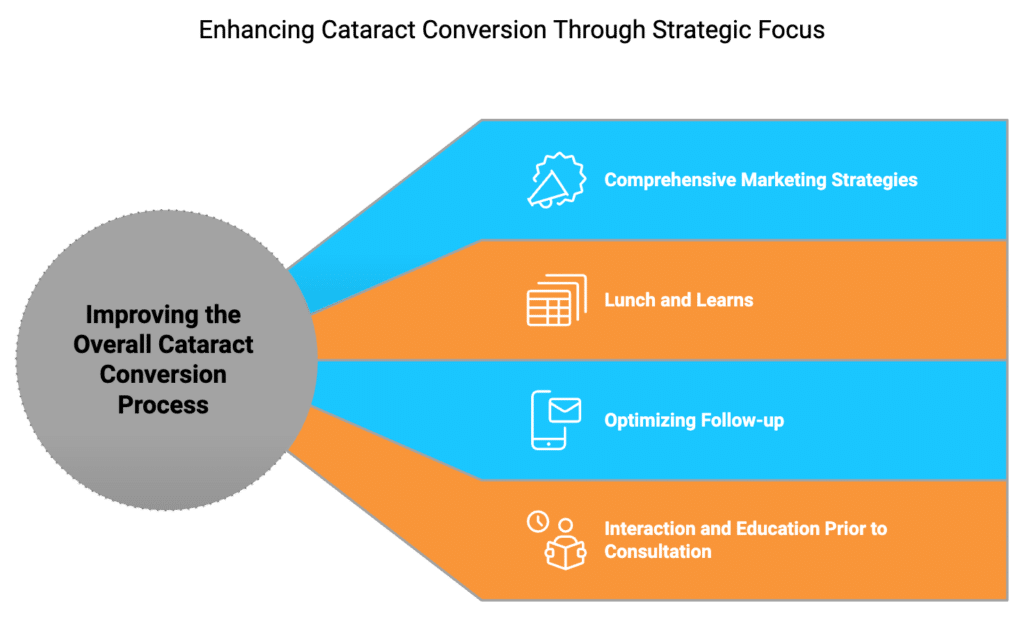
Creating a Complete Cataract Surgery Marketing Funnel
Now is not the time for practices to ignore marketing or turn a blind eye to any inefficiencies in their processes. To stay competitive and maximize patient conversion, practices must strategically address key areas of their marketing and operational workflows.
Focusing on these four essential areas will not only help optimize patient engagement but also improve overall conversion rates in a highly competitive market:
1. Cataract Marketing
Let’s start at the beginning of the patient journey, where research is done and requests for information occur. Successful cataract surgery marketing plans must consider multiple touch-points in the patient journey.
This journey typically begins in two different places: Google and the optometrist’s office. Practices need to make sure they are putting their best foot forward in both of these initial touch-points—ensuring they have a strong online presence and effective communication with optometrists.
Ranking for searches on Google or other search engines alone will likely not be enough. For this reason, diversifying through new media and collaborating with optometrists is the best blend.
When evaluating the marketing landscape for cataract surgery, it’s clear that the opportunity is ripe. This is because most practices simply don’t market it effectively and typically have only a page or two on their website explaining the surgery and lens implant options.
In these cases, it is mostly up to the patient to figure it all out on their own, such as understanding ‘What is a premium lens implant and why do I need one?” There is a significant educational gap, so the first step is to provide more clear and comprehensive information within the website design.
For example, instead of just defining phacoemulsification, inform patients that they face a significant choice that will determine how they will see after cataract surgery and for the rest of their lives. It has become essential to address the lifestyle changes that can accompany cataract surgery and how they want to see for the remaining years of their life.
Choosing an IOL is a big decision and not one that’s easy to make for anyone approaching retirement. Here is a checklist of items to help practices better prepare and look more professional than their competition:
Your Website
Your website serves as the cornerstone of your cataract surgery marketing program, acting as your digital front door. For many patients, it’s also where a significant amount of research takes place. It’s important to first ensure any information you have about cataracts on your website guides them with clarity and confidence.
The page should include lifestyle questionnaires/self-tests, educational videos, and an introduction to the surgeons and their qualifications. Most importantly, it should educate patients on cataracts and lens implant choices.
Breaking this information down in a simple way will help them understand the various lens implant options and how this affects their future vision.
Search Engines
There are three components at play here: PPC, SEO and Map indexing. Surprisingly, many practices overlook Google Ads (PPC), though they consistently prove effective for generating new cataract leads.
When developing advertising for cataract surgery services, PPC campaigns offer immediate visibility. With such little competition in many markets, practices can secure the top search spot for a relatively minor cost. Google Ads can be a great opportunity to start a dialogue with patients and encourage them to take a self-test or lifestyle questionnaire.
These ads can help your practice be the first practice to engage in conversation with a patient and look professional doing it. The second aspect is the map indexing.
Three important positions exist in the Google Map Pack, and you need to try to get one of them. If you are not, you risk losing the opportunity to get calls and leads from the maps, and that means you are missing out on thousands of prospective patients.
The call volume alone is well worth the effort. In order to achieve solid results here, you need clean citations and a very well-optimized Google business profile.
The third aspect of dominating search is organic SEO. This is typically the area that practices put significant effort into and, therefore, many gain leads from getting in these top spots of an organic search.
The real issue here is that you need to be on page one to get leads. If you are not here, you are invisible.
Very few users ever click through to the second page of search results, making those page-one positions absolutely crucial for your practice’s visibility.
Landing Pages
Landing pages are critical for the paid search process for multiple reasons. First, they help you track and understand what your actual PPC marketing costs are.
Secondly, they present a clear and concise way to focus on the important services you want a patient to know about without the distraction of other ophthalmology services.
| Cataract | YTD | 2023 | Change | 2021 | 2019 | ||
|---|---|---|---|---|---|---|---|
| CTR | 8.04% | 7.42% | 0.63% | 7.02% | 5.72% | ||
| Conv. Rate | 6.90% | 8.17% | -1.26% | 10.22% | 4.05% | ||
| Cost Per Lead | $72.82 | $55.51 | $17.31 | $47.13 | $172.28 |
Lifestyle Questionnaires
By implementing a lifestyle questionnaire, you can both engage new patients and gain immediate insight into each lead’s unique characteristics.
Educational Videos
Recent research on engagement and education in lead-generation demonstrates that video will be a crucial aspect of attracting and converting potential customers. Video marketing for cataract surgery has shown particularly strong results, with many practices reporting higher engagement rates.
Many A/B tests have shown that video-heavy landing pages convert better. In social media advertising, we have seen better conversions with video testimonials from real patients.
These results highlight the growing importance of incorporating video content into modern lead-generation strategies.
Email Drip Campaigns
Drip campaigns also seem to be dramatically undervalued. Not only is it an extremely important part of the educational process, but it can be 100% automated and lay the groundwork for future patient engagement and conversion.
Email drip campaigns are crucial for lead conversion because they strategically nurture prospects through the sales funnel. Initial emails typically see higher open rates, capitalizing on the prospect’s fresh interest to make a strong first impression.
As the campaign progresses, subsequent emails build value by delivering educational content that addresses pain points and demonstrates your expertise. This approach keeps your brand top-of-mind while gradually building trust.
By maintaining a consistent presence in their inbox and including a clear call-to-action to schedule a consultation in each email, you provide multiple opportunities for conversion when the prospect is ready to take action. This is particularly effective because different leads may be ready to convert at different times in their journey, and having that scheduling option readily available ensures you never miss a conversion opportunity.
Having a diverse perspective of trends is useful and going into an uncertain economy will require some discipline. Recent analysis has shown that conversions are harder in 2024 than 2021, and that the cost per lead has more than doubled since 2019.
It’s important to understand these trends to make better decisions and to set proper expectations in the minds of administrators.
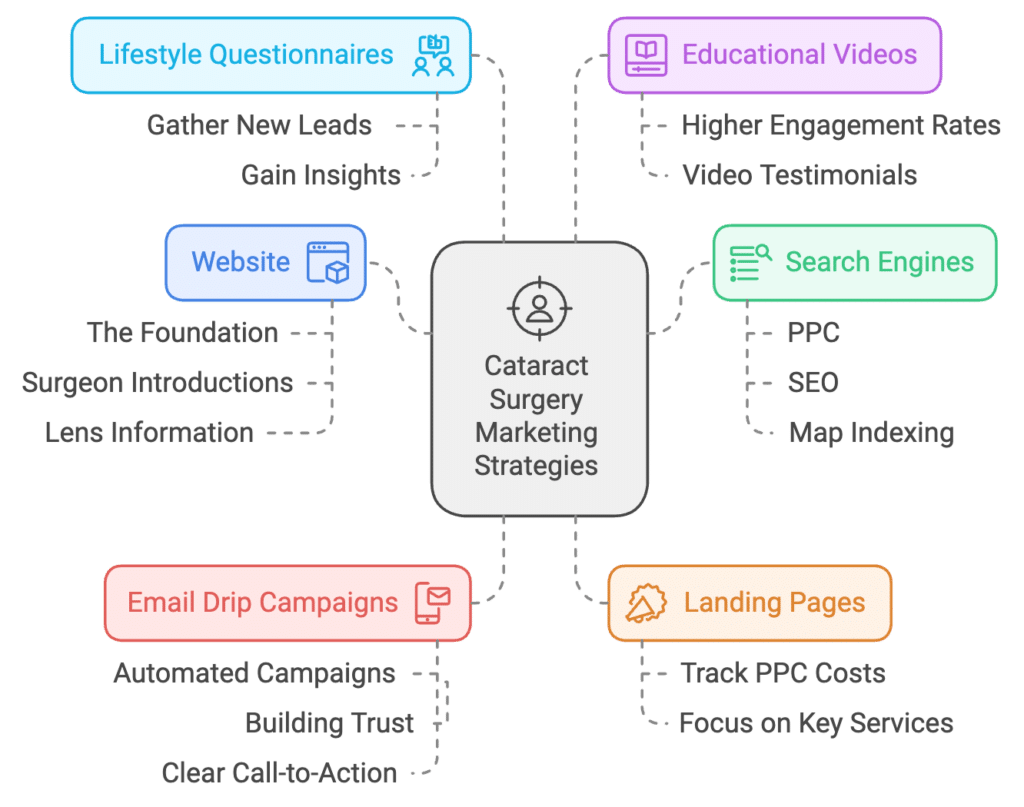
2. Cataract Lunch and Learns
While digital cataract surgery marketing is essential, traditional marketing approaches like Lunch and Learn events remain valuable. A Lunch and Learn is the opportunity to enjoy a complimentary lunch and learn more about a topic.
When hosting a Lunch and Learn about cataract surgery, you can discuss the procedure, lens options, and the newest technology available to help patients determine which lens may be best for them to achieve clear vision. Making these Lunch and Learn events free to attend, and encouraging guests to bring a spouse or friend along with them can be even more impactful for growing your practice.
When a patient is informed that they are developing a cataract and will need surgery, it’s very common to have questions surrounding the process and procedure.
Consider covering common questions, like:
- How do you know when it’s time to get cataract surgery?
- What happens during cataract surgery?
- What is recovery from cataract surgery like?
- Can cataract surgery correct other vision conditions?
- Do I want a standard IOL that Medicare will cover or a premium IOL?
3. Improve Lead to Conversion
Managing internal practice workflow and getting the right team has been a challenge for many practices since the COVID-19 pandemic. Managing incoming calls is challenging on its own.
Adding to this, many practices are struggling to retain technicians. To combat these challenges, it’s essential to establish clear best practices.
A common problem many practices face is failing to respond to patient inquiries submitted through their website contact forms. Getting back to these requests is critical—you’re receiving a steady stream of online inquiries about cataract surgery, but how many actually convert into consultations?
Optimizing your cataract surgery marketing funnel requires attention to each stage of the patient journey. The key is a strong follow-up process that includes immediate “speed to lead” responses, 24/7 availability, and staff with excellent phone and interpersonal skills. According to an oft-cited study by Lead Connect, 78% of consumers will choose the first business to respond to their inquiry.
The ZEISS SMILE team conducted extensive research with Laser Eye Institute and Dan Haddad, helping establish industry benchmarks. The study revealed that practices need to implement multiple outbound calls to leads and create drip campaigns for continued education. This includes following up multiple times via text, email, and phone.
This is perhaps the biggest breakdown in the conversion process, as the rates of patients moving from lead status to consultation are far too low. The patient is interested, or they would not have clicked, read the landing page and then completed a contact form to engage with the practice.
The good news is that there are now options for solving this problem with new solutions that can allow practices to increase their lead-to-conversion rate. Many companies offer secret shopper evaluations to assess your current performance and identify areas for improvement.
Glacial Multimedia provides comprehensive services to address these communication challenges, including email drip campaigns, which can automatically nurture leads with targeted educational content, procedure information, and patient testimonials over time to maintain engagement and encourage consultation bookings.
4. Interaction & Education Prior to Consultation
The goal of patient education is to empower patients to make an informed decision for their visual health. In today’s world, where information is available with a quick web search, it is extremely important to ensure the patient receives the right information at the right time.
Educating patients prior to the cataract consultation sets appropriate expectations, enhances patient understanding of their available options, and builds trust in the practice they have chosen for their care. Patients that arrive for their consultation well-informed about their surgical options, including the expectations for out-of-pocket expenses, have been shown to select premium lens technology at 30% higher rates than those who first learn about their options during the consultation visit.
This leads to patients who are more satisfied with their outcomes and practices seeing a significant increase in surgical revenue.
Dr. Edward J. Holland, Ophthalmologist at Cincinnati Eye Institute, states:
“Today’s cataract patient has more options than ever to achieve excellent postoperative vision. The variety of IOLs can be confusing and patient education is critical to meet expectations. Having an educational program is extremely valuable and can reduce the surgeon’s chair time as well as improve patient satisfaction.”
The added benefits of connecting the patient with an expert prior to their consultation include a reduced likelihood to cancel or reschedule their appointment, time savings for both patient and clinical staff members in the office, and an increase in the volume of patients proceeding with surgery within the first ninety days. The process does not just stop with the pre-consult education but must continue throughout the consult and into the evaluation process where the patient almost sees this as a partnership with the surgeon being the ultimate guide.
This is exactly the opposite of a sales pitch. If the conversation is approached like the surgeon is a guide to help them achieve their personal best vision, the whole experience feels better for both patient and surgeon.
If the patient still appears confused by the end of the evaluation it’s important to spend more time and break it down. Many physicians will start using visual objects and videos at this point to further explain any complex ideas and eliminate confusion on the astigmatism component or presbyopia component, for example.
“Practices can reduce the burden on their surgeons by educating patients prior to their evaluation and allowing them additional time to consider what options may be best for their lifestyle and their budget. In this model, the patient-surgeon interaction is more personalized to what the patient is a candidate for without feeling sold to and without the patient feeling blind-sided by out-of-pocket expenses after the lens discussion. These conversations now take less time in the office while leading to higher adoption rates of advanced technology offerings.”
Chris Bonsall – Navigate
Your Next Steps Towards an Excellent Cataract Surgery Marketing Program
Now is the time for practices to take a hard look at their cataract surgery programs and implement these proven strategies for growth and sustainability. With reimbursement cuts continuing and LASIK volumes declining, focusing on comprehensive marketing, educational events, lead conversion, and pre-consultation engagement has become essential rather than optional.
The data clearly shows that practices investing in these four key areas are seeing significant returns, with better-educated patients choosing premium IOLs at higher rates and fewer consultation cancellations. By implementing a comprehensive cataract surgery marketing and education strategy, practices can build a stronger program for the future.
Ready to Strengthen Your Cataract Program?
Let’s discuss how these strategies can work for your practice. Contact our team to review your current process and discover opportunities for growth.

